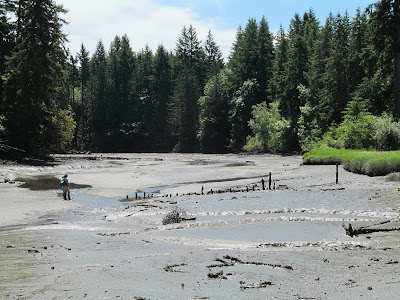 |
| My, what sharp shins you have. Note a fortuitous blade of grass for comparison. |
In the wilds of,...my front yard, the hunter became the hunted. Cliche, but true, all conveniently presented on a grassy lawn with no obstruction, and anough time to grab my camera.
I was just arriving home, when I heard a violent screeking, and looked over to see a small hawk pinning a starling to the ground by my doorstep. In no mood to share her prey, she flew over to the neighbor's yard, where it became evident that this was one starling no longer singing its foreign songs, and the racket was the hawk's victory chant.
 |
| Mine! Mine! Mine! |
"She?" Probably, based on the word of the Fish and Wildlife biologist who I sent these photos to. Juvenile, perhaps. Smaller than a Coopers, which would make it a Sharp Shinned Hawk in these parts. A native culling a flock of invasives. One down, thousands to go.
 |
 |
| No bird for you, alien feline. |
This is just one of the neighborhood cats (the ferals mostly fall to coyotes, I think), but to watch it come in, fast and low, ready for a pounce after the run, was to see the hunter that lives in most house-cats. It came out of nowhere (OK, probably the alley behind me), answering the dinner call. Was it like me, thinking it heard a bird in distress? Or have the cats learned the hawk's "I killed a freakin' starling!" song? This unwild-cat was probably not ready to hunt the hunter, but would steal a starling if it could.
This time, it could not. But it did make me wonder about how this works out on the big scale. I mean, a huge flock of starlings in the fairly open setting of single family homes placed at about 8 to the acre in 1950 may (despite their European roots and havoc wrought on native birds) be a boon to the bird-hunting hawk. But how many times does the native raptor make a kill only to have it taken away by a cat? Or, how much of a hawk's time is spent eluding pets hungry for yet another hand-out? The massive toll of cats directly killing wild birds has only recenltly become clear (billions, by the way, if not billions and billions), but what about the effects of harrassment and competition on native predators?
 |
| Late arrival, eating nothing. |
Off on a tangent, as usual. But in deference to the internet (for once), I did want to post some cat photos, and also to rant about something. Maybe cats have little or no effect on hawks' well-being, and although it could be said that the human tendency to clear forest, erect power-pole perches, and attract rodents (and scads of starlings) could benefit some raptors, our net effect is not so kind, what with overall habitat loss and diminishment of the native prey to which they adapted since time immemorial. Our footprint stomps out more native species than the cats, and after all, they would not be here without us, or hera and feral without our cavalier neglect.
Hopefully, by now, nobody is even reading this post. The hawk-photos were the point. The cat-blogging? Not so much.














































